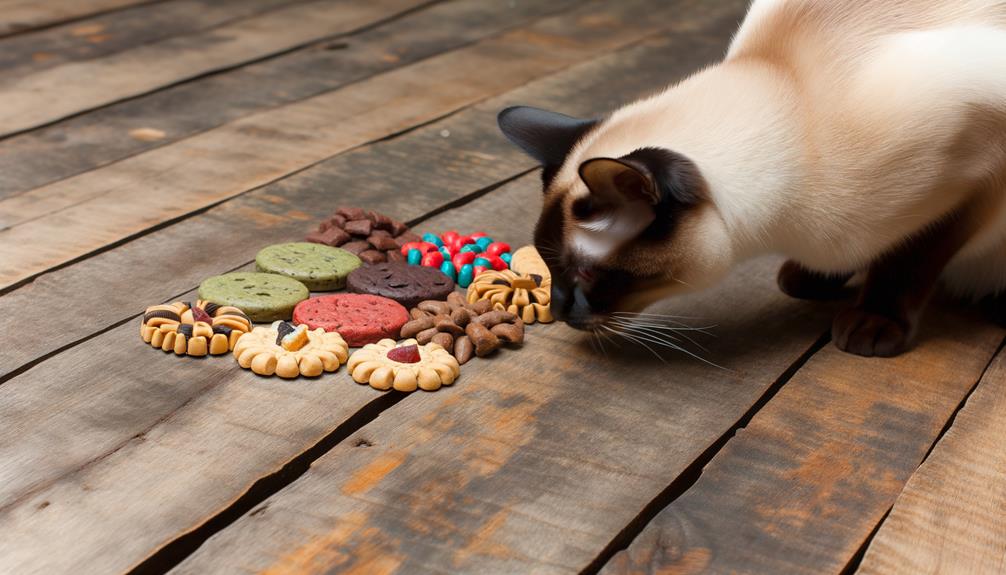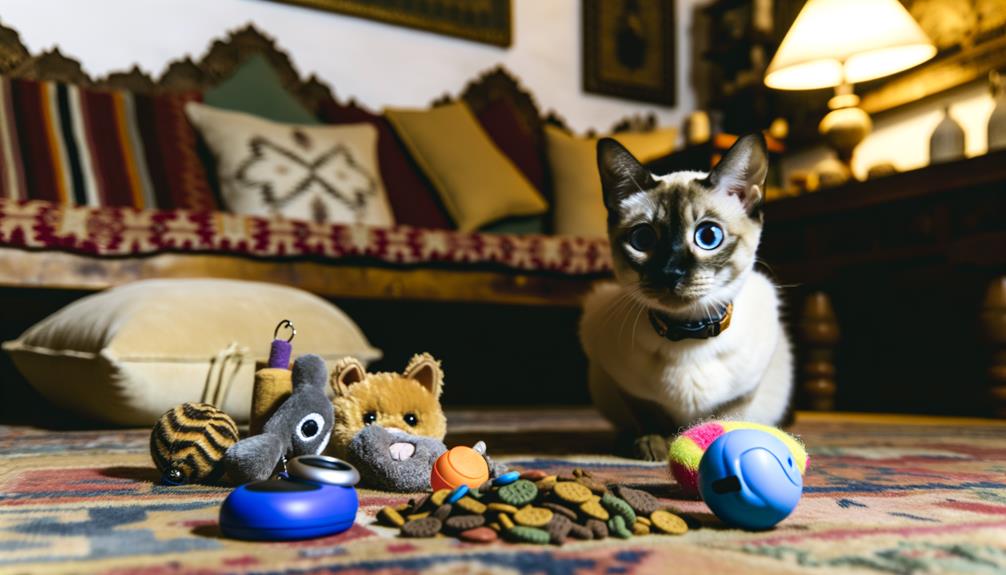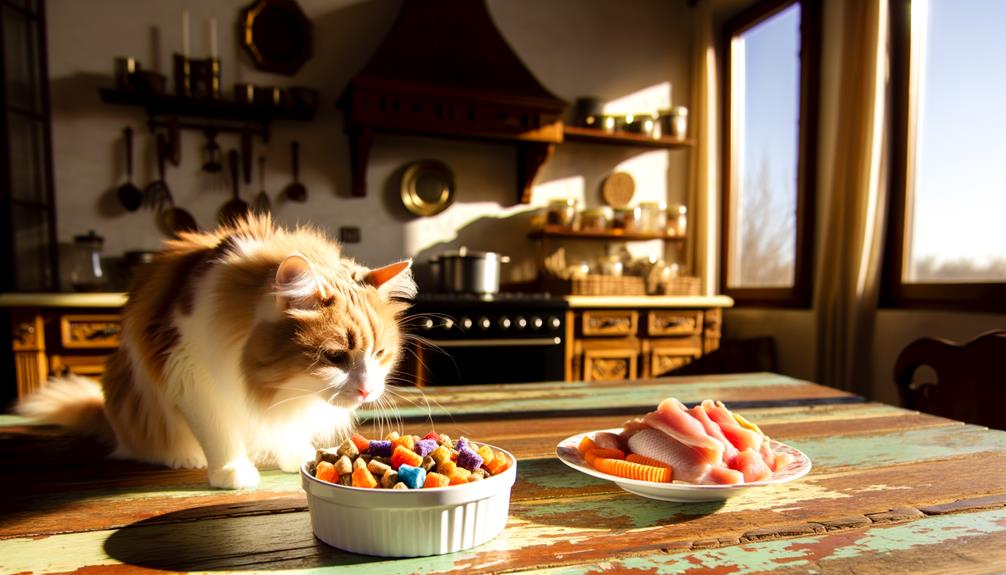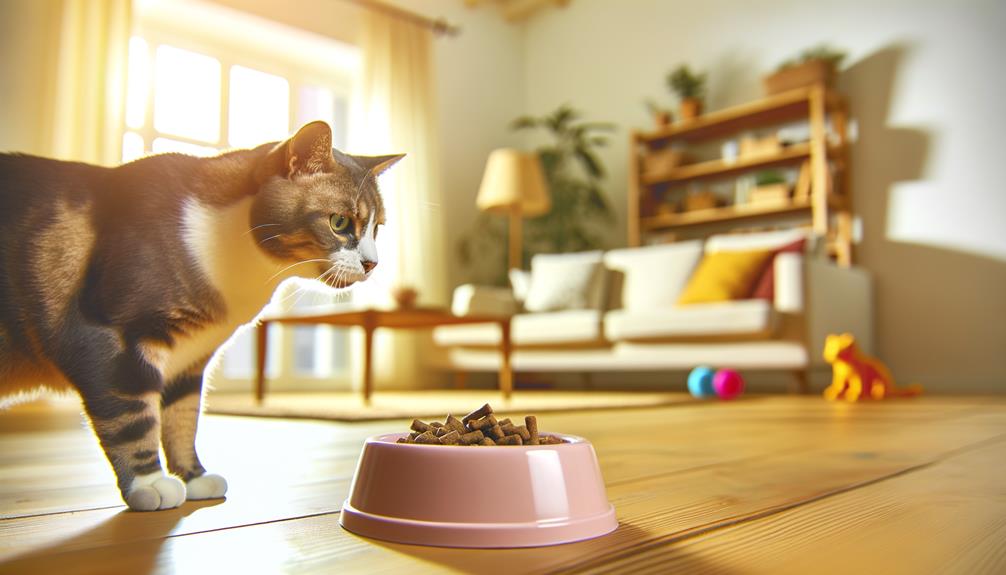Have you ever wondered why your cat turns its nose up at treats that other cats seem to adore? It might not be as straightforward as simple pickiness. Your cat's aversion could stem from past negative experiences, specific breed tendencies, or even underlying health issues. Factors like free feeding and dental problems can also play significant roles. Understanding these nuances can help you address the issue more effectively. So, what should you be considering when trying to tempt your feline friend with a treat?
Picky Eating Habits
Picky eating habits in cats can be attributed to a variety of factors that influence their dietary preferences and behaviors. One significant factor is a history of free feeding, which can diminish your cat's motivation to engage with treats. When food is always available, your cat may not see treats as a special reward, thus impacting their training and motivation.
Specific breeds, such as orange tabbies, may inherently show less interest in treats, indicating that individual preferences play a role in their eating habits. Past experiences with treats, particularly negative associations or being raised on a strict dry food diet, can further influence your cat's willingness to try new treats. A cat accustomed solely to dry food might even confuse it with treats, leading to disinterest in any additional offerings.
Cat owners often find that exposure to various types of food, such as wet food or table scraps, can make their cats more selective. This exposure can alter treat preferences, making your feline friend discerning or even dismissive of certain treats. Understanding your cat's favorite food types is vital for effective training and maintaining a balanced diet.
When considering how food is created and its impact on your cat's behavior, it is important to note that not all foods are perceived equally by cats. High-quality ingredients and palatability play a significant role in enticing a food-motivated cat. Consequently, identifying your cat's preferred food type—be it dry, wet, or a specific brand—can help you better navigate their picky eating habits.
Medical Concerns

A sudden decrease in your cat's interest in treats may serve as an early indicator of underlying health issues, requiring a thorough veterinary evaluation. This shift in eating habits can point to several medical concerns, which are vital to address promptly to guarantee your cat's health and well-being.
Dental disease is a common issue in cats that can greatly affect their ability to enjoy treats. Conditions such as gingivitis, periodontal disease, or tooth resorption can cause pain and discomfort, making it difficult for your cat to chew. Consequently, your cat may avoid treats altogether to prevent the associated discomfort.
Gastrointestinal problems, including inflammatory bowel disease or food allergies, can also affect your cat's treat consumption. These conditions may cause nausea, pain, or other digestive issues, leading your cat to reject treats to avoid exacerbating their symptoms.
Medications can play a role as well. Some drugs have unpleasant tastes or side effects, leading to negative associations with food and treats. If your cat is on medication, this could explain a sudden aversion to treats, as they may link the treat with the bitter taste or discomfort caused by the medication.
Obesity is another factor that can influence your cat's interest in treats. Cats with obesity or related metabolic disorders might have dietary restrictions or may have had negative experiences with food, leading to a reduced interest in treats. It is crucial to monitor your cat's eating habits and preferences regularly. Early detection of changes can facilitate timely veterinary intervention, guaranteeing that any underlying health issues are addressed before they escalate.
Treat Preferences

Understanding your cat's treat preferences requires recognizing that individual tastes and past experiences play significant roles in shaping their choices. Each cat's unique palate can lead to specific preferences for certain brands or types of treats. For instance, some cats may favor soft, chewy treats over hard, crunchy ones. Your cat's history with food can also influence their treat preferences. Cats raised on a strict dry food diet might display a disinterest in treats, especially if they haven't been exposed to varied textures and flavors early on.
Picky eating can stem from negative experiences with certain treats. If your cat has had a bad reaction to a particular treat, they're likely to associate all similar treats with that negative experience, leading to avoidance. In addition, some cats may not distinguish between their regular dry food and treats, reducing their food motivation to engage with what we consider higher value rewards.
Genetics can also play a role in treat preferences. Specific breeds, like orange tabbies, have been observed to show less interest in treats compared to other breeds. This suggests that genetic factors may influence treat appeal and overall food preferences.
To better understand your cat's treat preferences, consider their past experiences with food, their current diet, and their breed-specific tendencies. This all-encompassing approach will help you identify the types of treats that might appeal more to your feline friend, improving the likelihood that they'll show interest in the treats you offer. By recognizing these factors, you can better navigate the complexities of your cat's food preferences and enhance their overall treat experience.
Training Techniques

To effectively train your cat, leveraging the right techniques is vital for fostering positive behaviors. A systematic approach, particularly using treats, can greatly enhance your training outcomes.
Experimenting with various treat types can help you discover what resonates with your cat, as preferences can vary widely based on texture and flavor. For a food-motivated cat, breaking treats into smaller pieces can maintain their motivation during training sessions. This method encourages engagement without overwhelming them with large portions. High-value treats can be particularly effective in creating positive associations, especially when combined with clicker training. The clicker's sound, followed by a treat, reinforces the desired behavior, making it more likely to be repeated.
| Training Tip | Description | Benefit |
|---|---|---|
| Experiment with Treats | Try different textures and flavors | Identifies what your cat prefers |
| Smaller Portions | Break treats into smaller pieces | Maintains motivation without overfeeding |
| Clicker Training | Use a clicker to mark desired behavior before giving a treat | Enhances association between behavior and reward |
| High-Value Treats | Use treats your cat finds especially irresistible | Increases engagement and motivation |
| Consistency | Apply the same methods regularly | Reinforces desired behaviors for lasting results |
Counterconditioning techniques can also help if your cat initially dislikes certain treats. Gradually introducing the treat in a positive context can foster a more favorable response over time. Consistency in training methods, including the use of treats, is vital. Regularly applying the same techniques guarantees that your cat understands what's expected and reinforces desired behaviors.
Feeding Strategies

While training techniques can greatly improve your cat's behavior, the success of these methods often hinges on effective feeding strategies. Free feeding, where food is available at all times, can greatly diminish your cat's motivation for treats. When a cat eats continuously throughout the day, their desire to engage with food rewards decreases. To counteract this, you should implement scheduled feeding. By offering meals at specific times, you enhance your cat's food motivation, making them more likely to feel positively about treats during training.
Incorporating dietary variety is another vital component. Rotating different types of treats and foods can prevent dietary monotony and keep your cat interested. Experiment with various textures and flavors, such as freeze-dried options or lickable treats, to uncover your cat's preferences. This approach can greatly improve the efficacy of using treats in cat training.
Additionally, gradual introduction of new treats alongside familiar foods can reduce a cat's fear of unfamiliar items. When you make certain to introduce new items slowly, your cat is more likely to accept and anticipate the good thing that comes with these novel treats. This gradual approach not only broadens their dietary acceptance but also enhances their treat response.
Ultimately, feeding your cat strategically can have a profound impact on their training success and overall health. By adopting scheduled feeding and incorporating a variety of treats, you can optimize your cat's motivation and guarantee they respond positively during training sessions. These evidence-based strategies are essential for maintaining your cat's health and enhancing their behavioral outcomes.
